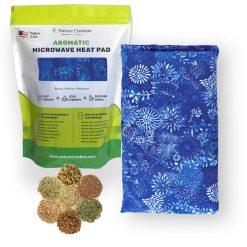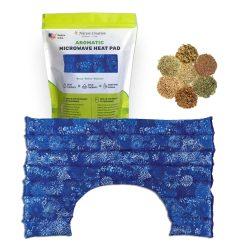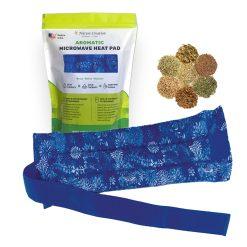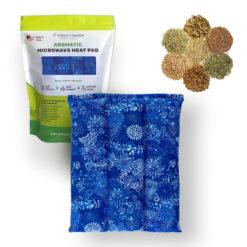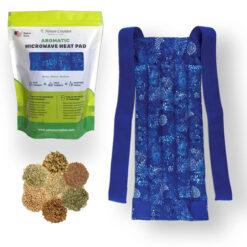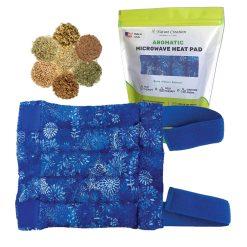Nothing beats the cozy embrace of a heating pad amidst winter’s icy touch, aches in your muscles, or when you simply wish to feel comfy. Apart from being economical and environmentally friendly, heating pads can be made rather simply! They aid in easing sore muscles, aid in period cramps, or can even be used just to feel a bit warmer when the temperature dips too low. The best part is that the pads are easy to create and ideal for doing it yourself.
Today’s blog will give you insight into creating a heating pad, how it operates, and its importance in your self-care kit.
So, let’s jump in!
Methods to Make a Homemade Heating Pad
Creating a homemade heating pad is not complicated. All that is required for the process to go smoothly is a little planning and a few essential items. So, here are two relatively easy and common methods.
1. Rice Heating Pad
Undoubtedly, it is the most common and easiest method.
Materials Needed:
- A clean sock or fabric (flannel or cotton works best)
- Uncooked rice (about 2-3 cups)
- Essential oils (optional for fragrance)
- A needle and thread or a sewing machine
Steps:
- The sock or fabric pouch should be filled with uncooked rice. Add a few drops of essential oils for a soothing scent.
- Stitch the loose end tightly to avoid spills.
- Warm up the pouch in the microwave for a couple of minutes until it’s heated thoroughly.
- Feel the warmth!
2. Herbal Heating Pad
For a bit more aromatic and soothing experience, try this herbal version.
Materials Needed:
- Fabric (cotton or flannel)
- Dried herbs like lavender, chamomile, or rosemary
- Uncooked rice or flaxseeds
- Essential oils (optional)
- Needle and thread or sewing machine
Steps:
- In a mixing bowl, combine rice/flax with dried herbs. Add essential oil if preferred.
- Cut a rectangle of fabric and sew it together on three sides only.
- Fill the pouch with your rice and herb mixture, ensuring it’s not overstuffed.
- Stitch the pouch shut.
- Pop it into the microwave for 1-2 minutes and be guided by its soothing aroma. Get ready to enjoy!
Herbal Microwave Heating Pads by Nature Creation
How a Homemade Heating Pad Can Help You
A homemade heating pad is more than just a source of warmth. Here’s how it can benefit you:
Soothe Muscle Pain: It helps blood circulation and relaxes strained muscles, so this is great for shoulder soreness, lower back discomfort, or sore muscles after a workout.
Eases Menstrual Cramps: Heating pads can help much more, like in the case of lower abdomen cramps.
Coping strategies for relaxation: After a challenging day, using essential oils or herbs can help with relaxation. Warmth, along with aroma, helps calm one down.
Cost-effective and Environment-Friendly: A heating pad made at home is environmentally friendly as it is made of natural fibers. Unlike disposable heat packs, it can be used more than once.
How Does a Homemade Heating Pad Work?
A homemade heating pad helps the muscles and skin relax and increases blood flow. It can be used directly on the body. The ingredients like rice and flaxseed help retain the heat once the pad has been put into the microwave. It allows the heating pad to become the perfect choice by making it a multi-purpose tool for mental and physical well-being. Furthermore, essential oils and herbs provide an extra touch of relaxation benefits.
What is the Expected Longevity of a Homemade Heating Pad?
With proper care, a homemade heating pad can last a very long time, even a few years! Here are tips to make sure you get the most use out of it:
- Make sure not to overheat it in the microwave as it might burn the content or the fabric.
- Mold and mildew growth can be avoided by storing it in a dry area.
- Replace the fabric immediately when it starts wearing off, and reuse the filling along with it.
What Precautions Should Be Maintained Before Using This Pad?
Although homemade heating pads are usually safe, it is essential to adhere to the following precautions:
Check The Temperature Beforehand: Burns can be avoided by checking the temperature of the pad before placing it on the skin.
Avoid Overheating: Hot spots may develop if microwaved for greater than 1 minute at a time (30 seconds is preferred).
Do Not Place Directly Against The Skin: The skin should be shielded with a cloth or towel when using the pad to eliminate the risk of burns.
Regular Checks: Inspect for tears or holes to safeguard against leaks.
Not Ideal For Everyone: If the user has delicate skin or poor circulation, a doctor’s advice should be sought beforehand to ensure minimal damage.
Bottom Line
For tension and discomfort relief, or even simply for a little more cozy goodness, a customized organic homemade pad will do the trick. It is an efficient way to incorporate warmth and relaxation into one’s life and relieve aches.
At Nature Creation, the philosophy of using the power of nature to create easy solutions inspires us. Try out our herbal microwavable heating pads. That’s one step towards a more self-sustainable approach to heating pads, for example.
Would you like to ask any questions or share your personal experiences with us?
Let us know in the comments because we would love to hear from you!
In addition, make sure to check out our other blogs for additional natural living tips and tricks. As always, stay warm and cozy while connected with nature!




